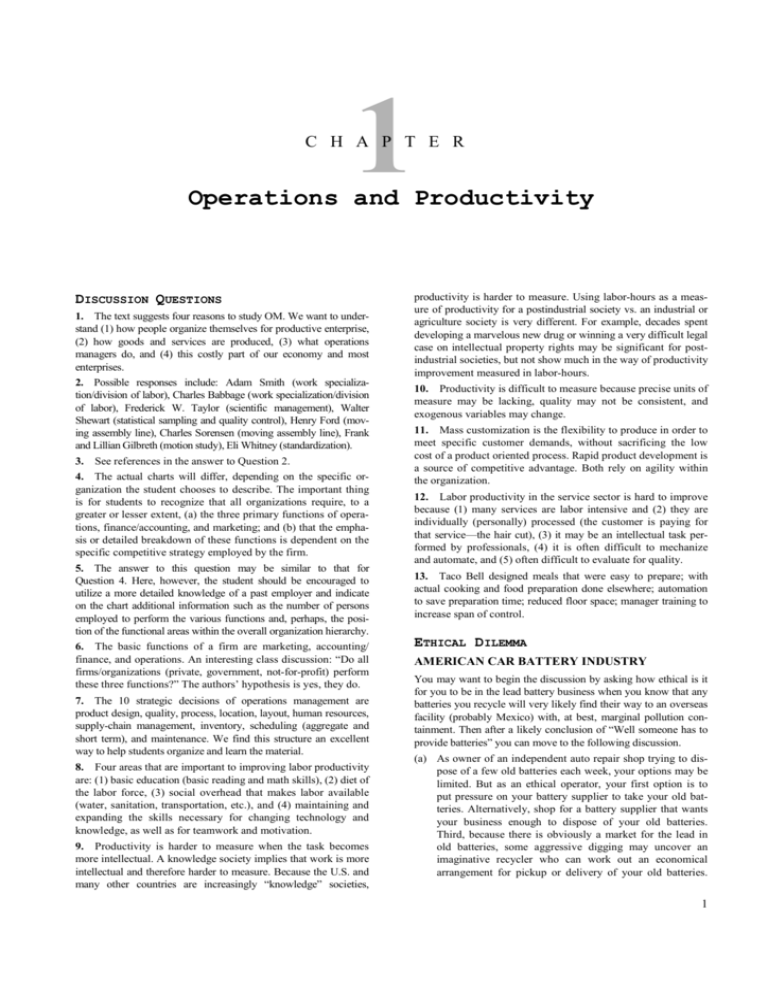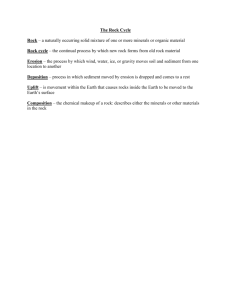
1
C H A P T E R
Operations and Productivity
DISCUSSION QUESTIONS
1. The text suggests four reasons to study OM. We want to understand (1) how people organize themselves for productive enterprise,
(2) how goods and services are produced, (3) what operations
managers do, and (4) this costly part of our economy and most
enterprises.
2. Possible responses include: Adam Smith (work specialization/division of labor), Charles Babbage (work specialization/division
of labor), Frederick W. Taylor (scientific management), Walter
Shewart (statistical sampling and quality control), Henry Ford (moving assembly line), Charles Sorensen (moving assembly line), Frank
and Lillian Gilbreth (motion study), Eli Whitney (standardization).
3. See references in the answer to Question 2.
4. The actual charts will differ, depending on the specific organization the student chooses to describe. The important thing
is for students to recognize that all organizations require, to a
greater or lesser extent, (a) the three primary functions of operations, finance/accounting, and marketing; and (b) that the emphasis or detailed breakdown of these functions is dependent on the
specific competitive strategy employed by the firm.
5. The answer to this question may be similar to that for
Question 4. Here, however, the student should be encouraged to
utilize a more detailed knowledge of a past employer and indicate
on the chart additional information such as the number of persons
employed to perform the various functions and, perhaps, the position of the functional areas within the overall organization hierarchy.
6. The basic functions of a firm are marketing, accounting/
finance, and operations. An interesting class discussion: “Do all
firms/organizations (private, government, not-for-profit) perform
these three functions?” The authors’ hypothesis is yes, they do.
7. The 10 strategic decisions of operations management are
product design, quality, process, location, layout, human resources,
supply-chain management, inventory, scheduling (aggregate and
short term), and maintenance. We find this structure an excellent
way to help students organize and learn the material.
8. Four areas that are important to improving labor productivity
are: (1) basic education (basic reading and math skills), (2) diet of
the labor force, (3) social overhead that makes labor available
(water, sanitation, transportation, etc.), and (4) maintaining and
expanding the skills necessary for changing technology and
knowledge, as well as for teamwork and motivation.
9. Productivity is harder to measure when the task becomes
more intellectual. A knowledge society implies that work is more
intellectual and therefore harder to measure. Because the U.S. and
many other countries are increasingly “knowledge” societies,
productivity is harder to measure. Using labor-hours as a measure of productivity for a postindustrial society vs. an industrial or
agriculture society is very different. For example, decades spent
developing a marvelous new drug or winning a very difficult legal
case on intellectual property rights may be significant for postindustrial societies, but not show much in the way of productivity
improvement measured in labor-hours.
10. Productivity is difficult to measure because precise units of
measure may be lacking, quality may not be consistent, and
exogenous variables may change.
11. Mass customization is the flexibility to produce in order to
meet specific customer demands, without sacrificing the low
cost of a product oriented process. Rapid product development is
a source of competitive advantage. Both rely on agility within
the organization.
12. Labor productivity in the service sector is hard to improve
because (1) many services are labor intensive and (2) they are
individually (personally) processed (the customer is paying for
that service—the hair cut), (3) it may be an intellectual task performed by professionals, (4) it is often difficult to mechanize
and automate, and (5) often difficult to evaluate for quality.
13. Taco Bell designed meals that were easy to prepare; with
actual cooking and food preparation done elsewhere; automation
to save preparation time; reduced floor space; manager training to
increase span of control.
ETHICAL DILEMMA
AMERICAN CAR BATTERY INDUSTRY
You may want to begin the discussion by asking how ethical is it
for you to be in the lead battery business when you know that any
batteries you recycle will very likely find their way to an overseas
facility (probably Mexico) with, at best, marginal pollution containment. Then after a likely conclusion of “Well someone has to
provide batteries” you can move to the following discussion.
(a) As owner of an independent auto repair shop trying to dispose of a few old batteries each week, your options may be
limited. But as an ethical operator, your first option is to
put pressure on your battery supplier to take your old batteries. Alternatively, shop for a battery supplier that wants
your business enough to dispose of your old batteries.
Third, because there is obviously a market for the lead in
old batteries, some aggressive digging may uncover an
imaginative recycler who can work out an economical
arrangement for pickup or delivery of your old batteries.
1
2
CHAPTER 1
OPERATIONS
AND
PRODUCTIVITY
Another option is, of course, to discontinue the sale of
Units produced 100 pkgs
1.5 (a)
=
= 20 pkgs/hour
batteries. (This a problem for many small businesses; ethical
Input
5
decisions and regulation may be such that they often place
133 pkgs
an expensive and disproportionate burden on a small firm.)
(b)
= 26.6 pkgs per hour
(b) As manager of a large retailer responsible for disposal of
5
thousands of used batteries each
Resource Last Year
This Year
Change
Percentage
1.6
week, you should have little
Change
trouble finding a battery supplier
1,000
1,000
0.31
with a reverse supply chain suitLabor
0.31
= 9.3%
= 3.33
= 3.64
3.33
300
275
able for disposal of old batteries.
Indeed, a sophisticated retailer,
1,000
1,000
2.22
Resin
2.22
= 11.1%
= 20
= 22.22
early on in any supply-chain
20
50
45
development process, includes
1,000
0.01
responsible disposal of enviCapital
= 0.09
= 10.0%
–0.01
000
ronmentally dangerous material
11,000
0.1
= 0.1
000
as part of the negotiations.
Disposal of old batteries should
1,000
1,000
0.02
Energy
= 6.1%
= 0.33
= 0.35
be a minor issue for a large re0.02
0.33
3,000
2,850
tailer.
6.6
(c) Increase in productivity =Last =Year
33.0% This Year
1.7
20
For both a small and large retailer, the solution is to find a
Production
1,00
1,00
“sustainable” solution or get out of the battery business. Burying
0
0
the batteries behind the store is not an option. Supplement 5:
Sustainability in the Supply Chain provides some guidelines for a
Labor hr. @ $10
$3,000
$2,750
deeper class discussion.
Resin @ $5
250
225
END-OF-CHAPTER PROBLEMS
1.1 (a)
(b)
110
1,42
5
$4,510
125 boxes
= 3.125 boxes/hour
40 hours
0.125 boxes
= 4.166%
(d) Percentage change =
3.0
(a) Labor productivity is 160 valves/80 hours = 2 valves
per hour.
(b) New labor productivity = 180 valves / 80 hours =
2.25 valves per hour
(c) Percentage change in productivity = .25 valves / 2
valves = 12.5%
1.3
100
1,50
0
$4,850
120 boxes
= 3.0 boxes/hour
40 hours
(c) Change in productivity = 0.125 boxes/hour
1.2
Capital cost/month
Energy
0.15 =
So L =
57,600
, where L number of laborers
(160)(12)(L)
employed at the plant
57,600
= 200 laborers employed
(160)(12)(0.15)
1.4 Bureau of Labor Statistics (stats.bls.gov) is a good place to
start. Results will vary for each year, but overall data for the
economy will range from .9% to 4.8%, and mfg. could be as
high as 5% and services between 1% and 2%. The data will vary
even more for months or quarters. The data are frequently revised,
often substantially.
[(1,000 / 4,850) (1,000 / 4,510)]
(1,000 / 4,850)
0.206 0.222 0.016
=
= 0.078 fewer resources
0.206
0.206
7.8% improvement*
* with rounding to 3 decimal places.
Output
1.8 Productivity =
Input
65
65
=
(520 × 13)
$6,760
= .0096 rugs per labor $
(a) Labor productivity =
65
(b) Multifactor
productivity (520 × $13) + (100 × $5) + (20 × $50)
=
65
= .00787 rugs per $
$8,260
1.9 (a) Labor productivity = 1,000 tires/400 hours = 2.5
tires/hour.
CHAPTER 1 O P E R A T I O N S
(b) Multifactor productivity is 1,000 tires/(400 ×
$12.50 + 20,000 × $1 + $5,000 + $10,000) =
1,000 tires/$40,000 = 0.025 tires/dollar.
1.10
This Year
1,500
1,500
= 4.29
Capital
vested
in-
Energy (btu)
= 4.62
1,500
= 0.10
1,500
= 0.08
15,000
18,000
1,500
1,500
= 0.50
3,000
2,750
3
Change
0.33
Percent Change
= 7.7%
4.29
325
350
PRODUCTIVITY
(c) Multifactor productivity changes from 1,000/40,000 to
1,000/39,000, or from 0.025 to 0.02564; the ratio is
1.0256, so the change is a 2.56% increase.
Last Year
Labor hrs.
AND
= 0.55
0.02
= –20%
0.1
0.05
= 10%
0.50
Productivity of capital did drop; labor productivity increased as did energy, but by less than the anticipated 15%.
1.11
Multifactor productivity is:
375 autos/[($20 × 10,000) + ($1,000 × 500) +
($3 × 100,000)] = 375/(200,000 + 500,000 +
300,000) = 375/1,000,000
= .000375 autos per dollar of inputs
1.12
(a) Before: 500/20 = 25 boxes per hour;
1.13
1,500 × 1.25 = 1,875 (new demand)
Outputs
= Productivity
Inputs
1,875
= 2.344
Labor-hours
1,875
New process =
800 labor-hours
2.344
800
= 5 workers
160
1,500
Current process =
= 2.344
labor-hours
1,500
= labor-hours 640
2.344
640
= 4 workers
160
Add one worker.
1.14
(a) Labor change:
1,500
1,500
=
= .293 loaves/$
(640 × $8) 5,120
1.17
$ output
52($90) + 80($198)
=
Labor-hours
8(45)
20, 520
=
= $57.00 per labor-hour
360
1,875
= 0.293 loaves/$
(800 × $8)
(b) Investment change:
6,600 vans
= 0.11, so x 60,000 labor-hours
x labor-hours
60,000 labor-hours
so,
200 labor-hours/laborer
300 laborers
on average, per month
(b) Now
1,500
1,500
=
= .293 loaves/$
(640 × $8) 5,120
1,875
1,875
=
= .359 loaves/$
(640 × 8) + (100) 5,220
.293 – .293
(c) Percent change :
= 0 (labor)
.293
.359 – .293
Percent change :
= .225
.293
= 22.5% (investment)
CHAPTER 1
4
OPERATIONS
AND
PRODUCTIVITY
After, 650/24 = 27.08
(b) 27.08/25
= 1.083, or an increase of 8.3% in productivity
(c) New labor productivity = 700 / 24 = 29.167
boxes per hour
Old process =
1.15
=
New process =
=
Percent change =
1.16
(a)
1,500
(640 8) + 500 + (1,500 0.35)
1,500
= 0.244
6,145
1,875
(800 8) + 500 + (1,875 0.35)
1,875
= 0.248
7,556.25
0.248 – 0.244
= 1.6%
0.244
6,600 vans
= 0.10
x labor-hours
x = 66,000 labor-hours
There are 300 laborers. So,
66,000 labor-hours
= 220 labor-hours/laborer on average, per month
300 laborers
CHAPTER 1
ADDITIONAL HOMEWORK PROBLEM
Problem 1.18 appears at www.myomlab.com and
www.pearsonhighered.com/heizer.
1.18
Last year =
1,500
(350 8) + (15,000 0.0083) + (3,000 0.6)
1,500
2,800 124.50 1,800
1,500
0.317 doz / $
4,724.5
1500
This year =
(325 8) + (18,000 0.0083) + (2,750 0.6)
OPERATIONS
Product design: Each of Frito-Lay’s 40-plus products
must be conceived, formulated (designed), tested
(market studies, focus groups, etc.), and evaluated for
profitability.
Quality: The standards for each ingredient, including its
purity and quality, must be determined.
Process: The process that is necessary to produce the
product and the tolerance that must be maintained for
each ingredient by each piece of equipment must be
specified and procured.
Location: The fixed and variable costs of the facility, as
well as the transportation costs in and the delivery
distance, given the freshness, must be determined.
Layout: The Frito-Lay facility would be a process
facility, with great care given to reducing movement of
material within the facility.
Human resources: Machine operators may not have
inherently enriched jobs, so special consideration must be
given to developing empowerment and enriched jobs.
Supply-chain management: Frito-Lay, like all other producers of food products, must focus on developing and
auditing raw material from the farm to delivery.
Inventory: Freshness and spoilage require constant effort
to drive down inventories.
Scheduling: The demand for high utilization of a capitalintensive facility means effective scheduling will be
important.
Maintenance: High utilization requires good maintenance, from machine operator to the maintenance
department and depot service.
CASE STUDY
NATIONAL AIR EXPRESS
This case can be used to introduce the issue of productivity and
how to improve it, as well as the difficulty of good consistent
measures of productivity. This case can also be used to introduce some of the techniques and concepts of OM.
1. The number of stops per driver is certainly a good place to
start. However, mileage and number of shipments will probably
be good additional variables. (Regression techniques, addressed in
Chapter 4, can be addressed here to generate interest.)
2. Customer service should be based on an analysis of customer
requirements. Document requirements in terms of services desired
(supply needs, preprinted waybills, package weights, pickup and
drop-off requirements) should all be considered. (The house of
quality technique discussed in Chapter 5 is one approach for such
an analysis.)
3. Other companies in the industry do an effective job of establishing very good labor standards for their drivers, sorters, and
phone personnel. Difficult perhaps, but doable. (Work measurement in Chapter 10 addresses labor standards.)
VIDEO CASE STUDIES
1
FRITO-LAY: OPERATIONS MANAGEMENT
IN MANUFACTURING
This case provides a great opportunity for an instructor to stimulate
a class discussion early in the course about the pervasiveness of the
10 decisions of OM with this case alone or in conjunction with the
Hard Rock Cafe case. A short video accompanies the case.
5
0.341 doz / $
0.341 0.317
0.317
0.076, or 7.6% increase
PRODUCTIVITY
1. From your knowledge of production processes and from the
case and the video, identify how each of the 10 decisions of OM
is applied at Frito-Lay:
Percent change =
AND
2. How would you determine the productivity of the production
processes at Frito-Lay?
Determining output (in some standard measure, perhaps pounds)
and labor-hours would be a good start for single-factor productivity.
For multifactor productivity, we would need to develop and
understand capital investment and energy, as well as labor, and
then translate those into a standard, such as dollars.
3. How are the 10 decisions of OM different when applied by
the operations manager of a production process such as
Frito-Lay than when applied by a service organization such as
Hard Rock Cafe?
Hard Rock performs all 10 of the decisions as well, only with a
more service-sector orientation. Each of these is discussed in the
solution to the Hard Rock Cafe case.
6
CHAPTER 1
OPERATIONS
AND
PRODUCTIVITY
HARD ROCK CAFE: OPERATIONS
MANAGEMENT IN SERVICES
2
There is a short video (7 minutes) available from Pearson Prentice Hall and filmed specifically for this text that supplements this
case.
1. Hard Rock’s 10 decisions: This is early in the course to
discuss these in depth, but still a good time to get the students
engaged in the 10 OM decisions around which the text is
structured.
Product design: Hard Rock’s tangible product is food and
like any tangible product it must be designed, tested, and
“costed out.” The intangible product includes the music,
memorabilia, and service.
Quality: The case mentions the quality survey as an overt
quality measure, but quality can be discussed from
a variety of perspectives—hiring the right people,
food ingredients, good suppliers, speed of service,
friendliness, etc.
Process: The process can be discussed from many
perspectives: (a) the process of processing a guest, to
their seat, taking the order, order processing, delivery of
the meal, payment, etc., (b) the process of how a meal is
prepared (see, for instance, the example box in Chapter 2
on Chef Pierre Alexander), or (c) some subset of any
of these.
Location: Hard Rock Cafes have traditionally been
located in tourist locations, but that is beginning to
change.
Layout: Little discussion in the case, but students may be
very aware that a kitchen layout is critical to efficient
food preparation and that a bar is critical in many food
establishments for profitability. The retail shop in relation
to the restaurant and its layout is a critical ingredient for
profitability at Hard Rock.
Human resources: Jim Knight, VP for Human Resources
at Hard Rock, seeks people who are passionate about
music, love to serve, can tell a story. This OM decision is a
critical ingredient for success of a Hard Rock Cafe and an
integral part of the Hard Rock dining experience.
Supply-chain management: Although not discussed in the
case, students should appreciate the importance of the
supply chain in any food service operation. Some items like
leather jackets have a 9-month lead time. Contracts for meat
and poultry are signed 8 months in advance.
Inventory: Hard Rock, like any restaurant, has a critical
inven-tory issue that requires that food be turned over
rapidly and that food in inventory be maintained at the
appropriate and often critical temperatures. But the
interesting thing about Hard Rock’s inventory is that they
maintain $40 million of memora-bilia with all sorts of
special care, tracking, and storage issues.
Scheduling: Because most Hard Rock Cafe’s sales are
driven by tourists, the fluctuations in seasonal, daily, and
hourly demands for food are huge. This creates a very
interesting and challenging task for the operations
managers at Hard Rock. (Not mentioned in the case,
linear programming is actually used in some cafes to
schedule the wait staff.)
Maintenance/reliability: The Hard Rock Cafe doors must
open every day for business. Whatever it takes to provide
a reliable kitchen with hot food served hot and cold food
served cold must be done. Bar equipment and point-ofsale equipment must also work.
2. Productivity of kitchen staff is simply the output (number of
meals) over the input (hours worked). The calculation is how many
meals prepared over how many hours spent preparing them. The
same kind of calculation can be done for the wait staff. In fact,
Hard Rock managers begin with productivity standards and staff
to achieve those levels. (You may want to revisit this issue when
you get to Chapter 10 and Supplement 10 on labor standards and
discuss how labor can be allocated on a per-item basis with more
precision.)
3. Each of the 10 decisions discussed in Question 1 can be
addressed with a tangible product like an automobile.
Product design: The car must be designed, tested, and
costed out. The talents may be those of an engineer or
operations manager rather than a chef, but the task is the
same.
Quality: At an auto plant, quality may take the form of
measuring tolerances or wear of bearings, but there is still
a quality issue.
Process: With an auto, the process is more likely to be an
assembly-line process.
Location: Hard Rock Cafe may want to locate at tourist
destinations, but an auto manufacturer may want to go to a
location that will yield low fixed or variable cost.
Layout: An automobile assembly plant is going to be
organized on an assembly line criterion.
Human resources: An auto assembly plant will be more
focused on hiring factory skills rather than a passion for
music or personality.
Supply-chain management: The ability of suppliers to
contribute to design and low cost may be a critical factor
in the modern auto plant.
Inventory: The inventory issues are entirely different—
tracking memorabilia at Hard Rock, but an auto plant
requires tracking a lot of expensive inventory that must
move fast.
Scheduling: The auto plant is going to be most concerned
with scheduling material not people.
Maintenance: Maintenance may be even more critical in
an auto plant as there is often little alternate routing, and
down time is very expensive because of high fixed and
variable cost.
CHAPTER 1
OPERATIONS
AND
PRODUCTIVITY
7
ADDITIONAL CASE STUDY
ZYCHOL CHEMICALS CORPORATION*
1. The analysis of the productivity data is shown below:
Both labor and material productivity increased, but capital equipment productivity did not. The net result is a large negative change
in productivity. If this is a one-time change in the accounting procedures, this negative change should also be a one-time anomaly.
The effect of accounting procedures is often beyond the control
of managers. For example, perhaps the capital allocation is based
on an accelerated allocation of depreciation of newly installed
technology. This accounting practice will seriously impact nearterm productivity and then later years’ productivity figures will
benefit from the reduced depreciation flows. This highlights the
difficulty in accounting for costs in an effective managerial manner. Decisions and evaluation of operating results should be based
on sound managerial accounting practices and not necessarily
generally accepted financial accounting principles.
2. An analysis of adjusted results reduces the negative impact on
the capital allocation but there is still a negative growth in multifactor productivity. After adjustment for inflation, the material
costs are still higher in 2009. Yet, one must be aware of the extra
volatility of the cost of petroleum-based products. Did the man*
ager have control over his price increases? One should look at the
changes in a petroleum-based price index, including the cost of oil,
over the last two years in order to gain a better understanding of
the degree to which the manager had control over these costs. The
increase in wages was beyond the manager’s control and a constant rate should be used for comparing both years’ results. Yet a
negative result still remains. Even when material costs in 2009 are
converted to the original cost of $320, a negative 5% growth in
productivity remains. The increase in the capital base is responsible yet should not persist in future years if the increase was the
result of an adoption of new technology.
3. The manager did not reach the goal. An analysis of the
changes in capital costs is warranted. Even after adjusting for inflation, multifactor productivity was not positive. However, labor
and materials productivity was favorable. The capital investment
cost (as figured by the accounting department) was so large as to
make his multifactor productivity negative. Multifactor productivity has fallen by 11.61% before adjustment and by 7.88% after the
adjustment for inflation.
This case study is found on our Companion Web sites, www.pearsonhighered.com/heizer and www.myomlab.com.






